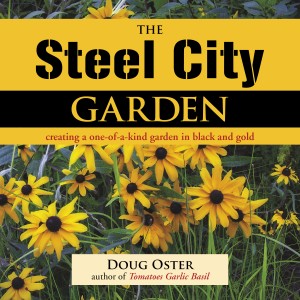The Steel City Garden
November 19th, 2013
When my son and daughter-in-law moved into a century-old house in a small town near Pittsburgh, one of the first things we did (as you might guess) was fix the atrocious landscaping.
In case you’re not terribly familiar with Pittsburgh, everything in that part of the state is rabid black and gold. Those colors have their roots deep in the city’s history, and all three of the city’s beloved sports teams (Steelers, Pirates, Penguins) proudly bear the black and gold.
So it seemed a natural to me that at least part of Andy and Julie’s front yard should have a Steel City garden of black and gold plants.
I figured every garden center out there would be pushing those colors since, as one garden-center staffer confirmed, Yinzers (the slang term for Pittsburghers) buy ANYTHING if it’s got black and gold or a Steelers logo on it.
Not so. None of the places we looked had any kind of Steel City garden display or any hint of a black-and-gold plant theme.
We jerry-rigged our own little corner garden, though, featuring a ‘Black Lace’ elderberry, a couple of gold-leafed ‘Mellow Yellow’ spireas, a few clumps of black mondo grass, and black-eyed susans and gold mums for seasonal color.
This may not be one of the apparent few Steel City gardens for much longer.
A new book by award-winning Pittsburgh garden writer Doug Oster hit the market this week, and it’s all about designing a distinctly Pittsburghish garden.
“The Steel City Garden: Creating a One-of-a-Kind Garden in Black and Gold” (St. Lynn’s Press, $17.95 hardcover) encourages planting Pittsburgh pride in the landscape and offers profiles on scores of gold plants, black plants and some that hit the Yinzer jackpot – both black and gold.
Gold is easy. You’ve got everything from golden string beans in the vegetable garden to gold-needled junipers along the border to golden celosia through golden zinnia in the flower garden.
But as Doug shows in the book, there are a lot more black plants than you might think… black elephant ears, black mondo grass, black-leafed sweet potato vines, black-blooming petunias, black-leafed bugbane, nearly black coleus, even black radishes.
Black-eyed susans, ‘Phantom’ petunias, pansy ‘Accord Black Beauty’ and sunflowers are among the plants that pack black and gold in a single package.
It’s a fun read even if you’re not a Pittsburgher – seeing what all can be put together to fit into the theme.
Of course, if you ARE a transplanted Yinzer, a fervent Steelers fan, or just a gardener who happens to like the look of gold with black, “The Steel City Garden” is your plant-selection manual.
The profiles are grouped by flowers, edibles and trees and shrubs, and each profile offers growing tips, details on where to plant each plant, pests and diseases to watch out for, and good partners for each.
I have to admit, though, my favorite part is the last of Doug’s three gardener profiles on locals with Steel City gardens. Andy is featured there along with a picture of our granddaughter, Leona, whom Andy and Julie brought into the gardening world 6 months ago. Little Leona hasn’t dug a hole yet, and she’s already in a gardening book.
I ran into Doug at this year’s Garden Writers Association conference when he was heading down the home stretch on the book.
Here’s a guy who must not sleep. He writes a “Backyard Gardener” column for the Pittsburgh Post-Gazette, does weekly garden videos for the paper, blogs, takes photos, runs a plant-swap event, does a Sunday radio show for KDKA, produced an Emmy Award-winning documentary on Pennsylvania gardens, leads garden trips and has now written five books. He also gardens on 4 acres.
Doug told me he wasn’t looking to do another book until Paul Kelly, his Pittsburgh-based St. Lynn’s Press publisher, came up with the Steel City Garden idea. He had a mockup of the cover and everything. It was too appealing of an idea to pass up and hard to believe that no one had ever thought to do it before.
At the Garden Writers conference, Doug said he was having a surprisingly hard time tracking down people with Steel City gardens to profile. Even after putting out the word, he wasn’t unearthing many black-and-gold gardens.
I’m glad an “imported Yinzer” could fill the void.
Now that the book is out, black-and-gold gardens should be popping up all over Yinzerland next spring.
After all, if ‘Black Lace’ elderberry, black mondo grass, black-eyed susans and golden daylilies aren’t standard fare in Pittsburgh yards, where will they be used?
To get a copy of the book and read more about Doug Oster, check out http://www.dougoster.com/.
For more on St. Lynn’s Press and its other gardening books, check out http://www.stlynnspress.com/.










